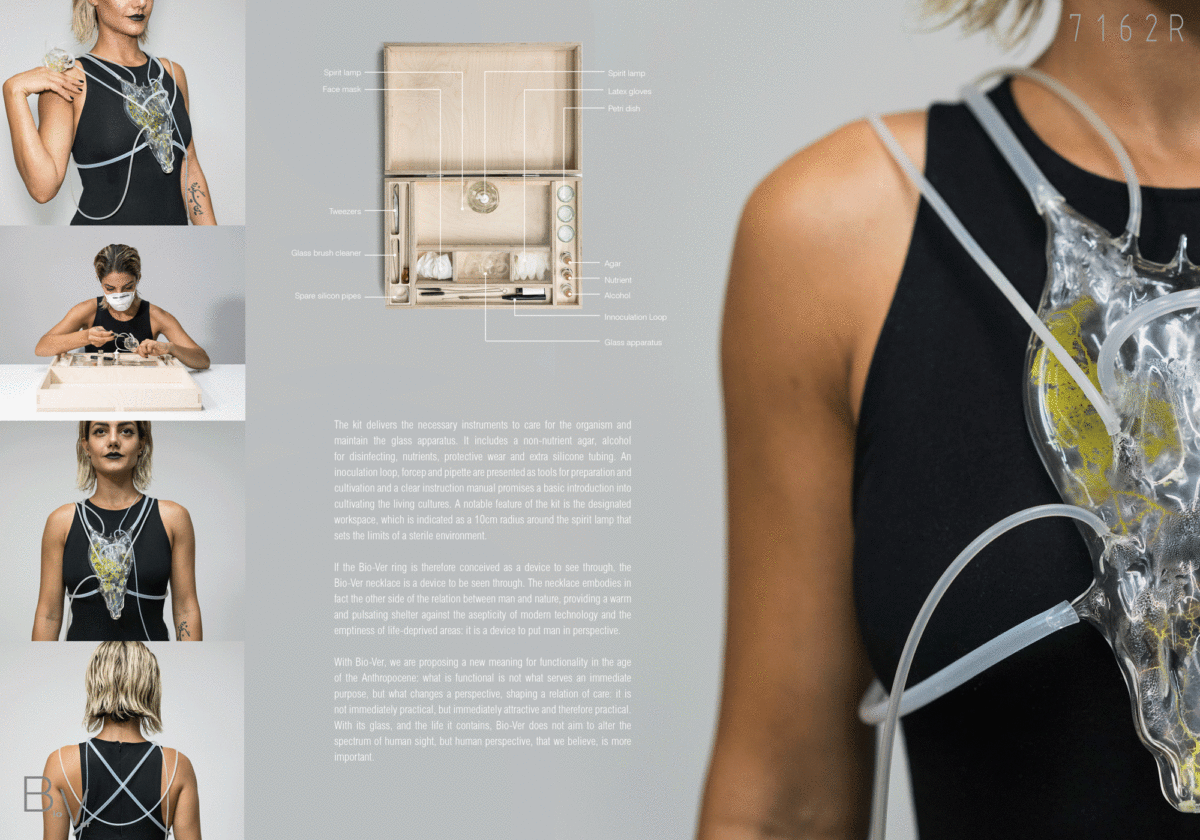RESHAPE18 | sensing materialities
wearable technology category
Bio Ver

Bio-Ver
Animated Adornment
Nature, inspired human technics since its beginning. To find shelter and enhance their physical limitations, humans have imitated animal dens, designed artificial claws and produced clothes to offset the lack of fur.
Today, advanced technologies and design solutions are allowing to use biomimicry not only to provide humans with an empowering yet all-consuming promethean flame, but to foster a new, responsible ‘return to nature’, inspiring practices of construction and of energy harnessing that are compatible with the limitedness of natural resources and have a gentler impact on the environment.
The possibility of this renewed relation to nature entails a change of rhythm, from the careless hyperspeed of capital-driven production to a slower pace, that tends to synchronise human activities with natural cycles, a new tempo allowing for reflection and the production of relations of care.
Surrounded by digital portable devices that affect our everyday life below the threshold of our attention, we propose an alternative analogical wearables with the aim to produce a change of perspective regarding attention, the sensing and observation of nature and the purposes of design.
As the revolution of portability changed the course of the development of digital technologies, substituting the pilgrimage to the desktop computer with a nomadism alongside digital devices, we propose a new paradigm shift grounded on the re-shaping of the petri dish. By unflattening of the laboratory glass we aim to challenge the relation of observation, to substitute the pilgrimage to nature through the lab desk, with a wandering alongside nature, fostering persistent attention and promoting practices of care towards living beings.
Our unfolded petri dishes, digitally redesigned as a ring and a necklace, are in fact inhabited by specimens of Physarum polycephalum, an protist observable by the naked eye that is highly sensitive to its environment. This bright yellow slime mould in constant search for nutrients exhibits exceptional problem solving capacities carried out through a sort of exteriorisation of its memory, literally building its future direction from and with past experiences.
We have designed a ring with the aim to put its wearer in the position of looking at the world through the pulsating rhythm of the life of the creature that contains, discouraging the practice of interfacing with life in a relation of pure externality between observer and observed, and promoting a new equilibrium between the hand, the eye and the world.
If the Bio-Ver ring is therefore conceived as a device to see through, the Bio-Ver necklace is a device to be seen through.
The necklace embodies in fact the other side of the relation between man and nature, a nature that grows upon us like musk on trees, surrounding us, providing a warm and pulsating shelter against the septicity of modern technology and the emptiness of life-deprived areas: it is a device to put the man in perspective.

The scale of the plasmodium of this creature trains to respect the invisible that surrounds its wearer and, assuming the function of a magnifier, the petri dish does not work as an enhancement of the eye, but as a means to develop symbiotic relations, to foster practices of interaction and therefore of care.
With Bio-Ver, we are proposing a new meaning for functionality in the age of the Anthropocene: what is functional is not what serves an immediate purpose, but what changes a perspective, shaping a relation of care: it is not immediately practical, but immediately attractive and therefore practical. With its glass, and the life it contains, Bio-Ver does not aim to alter the spectrum of human sight, but human perspective, that we believe is more important.


